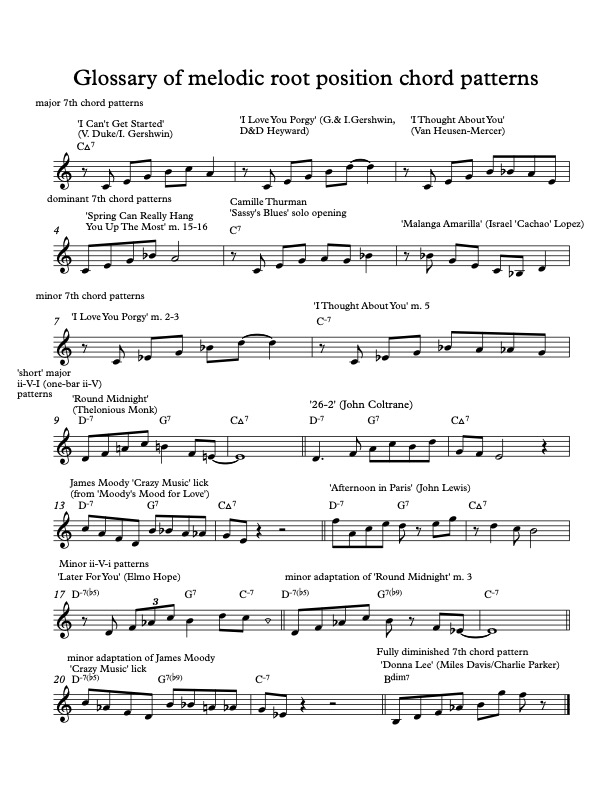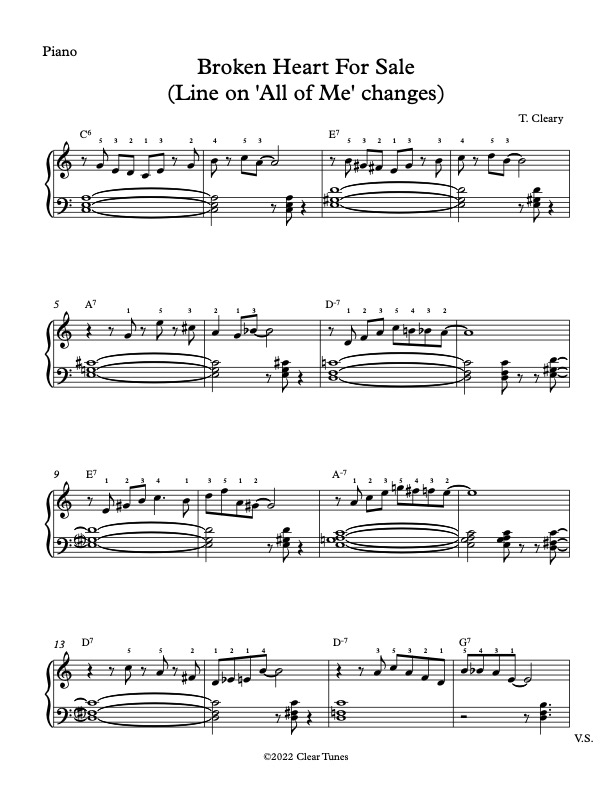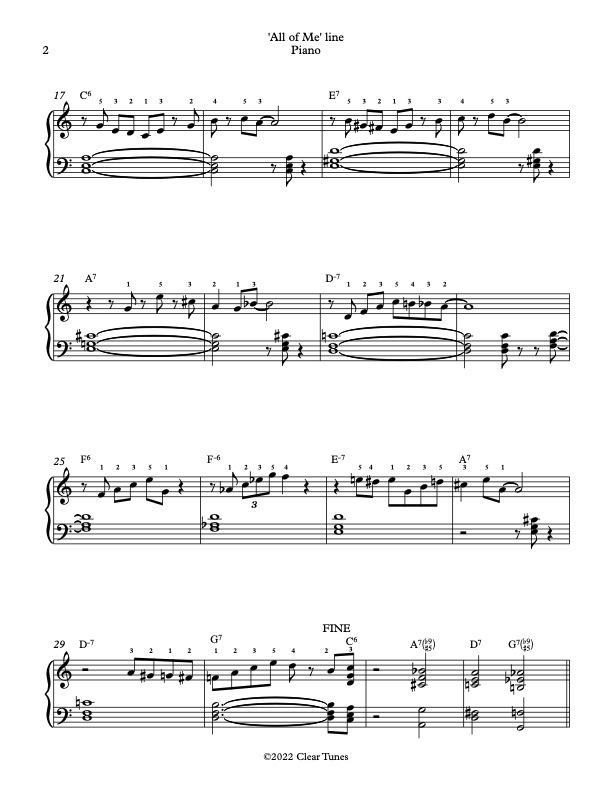The song ‘All of Me’ by Seymour Simons and Gerald Marks is a jazz standard which has been recorded by countless artists. Two versions which show the multiple possibilities the tune contains for improvisers are the studio version by Count Basie and his Orchestra, where Basie’s relaxed, minimalist approach to the melody alternates with aggressively swinging horn passages, and the somewhat faster version by Ella Fitzgerald arranged by Nelson Riddle, which features one of Fitzgerald’s classic quote-riddled scat solos (among the tunes she quotes here are ‘The Sailor’s Hornpipe’, ‘The Irish Washerwoman’ and ‘Heart of My Heart’). For some thoughts on where the opening chords to ‘All of Me’ may have originated, as well as some later tunes that have similar opening chords (including compositions by Robbie Robertson, Thelonious Monk, and one I wrote for the Mike Gordon band) see the last paragraph of this post.
‘Broken Heart for Sale’ is a tune I composed based on the chord changes to ‘All of Me’, partially inspired by Fitzgerald’s allusive approach to constructing a new melodic line on the tune’s changes. It uses melodic vocabulary from a ‘Glossary of Melodic Root Position Chord Patterns’ (a.k.a. GOMRoPChoP) that I developed as a tool to help students familiarize themselves with the basic jazz chord types by hearing them in the context of a strong melodic line:

The melody of my original tune is an effort to demonstrate the ‘innovate’ stage of the ’emulate, assimilate, innovate’ process that Clark Terry describes as being integral to the development of improvisers. While I borrow the opening gesture of ‘I Can’t Get Started‘ in the first measure, I rhythmically recontextualize by starting it on the downbeat of beat three (it originally begins on the ‘and’ of 3). I also precede it with a 3 note descending pattern. In m. 5, I borrow a melodic gesture from Israel ‘Cachao’ Lopez’s ‘Malanga Amarilla’, but I transpose the first note down an octave, remove a repeated note, use the flat 9 rather than the original natural 9, and remove the tail of the phrase. Other melodic phrases from the GOMRoPChoP that I use in ‘Broken Heart for Sale’ include m.5 from ‘I Thought About You‘, Camille Thurman’s solo on ‘Sassy’s Blues’, the ‘crazy music’ lick from ‘Moody’s Mood for Love’ (i.e., James Moody’s solo on ‘I’m In The Mood for Love’), ‘Later For You’ by Elmo Hope and ’26-2′ by John Coltrane.
Here is a link to my keyboard video of ‘Broken Heart For Sale’. While this is an instrumental version, I also have lyrics to the tune and hope to add a vocal version soon. After playing the head, which is accompanied with three note root position voicings, I begin my solo with a ‘melody scrabble’ approach, spontaneously reorganizing the pitch collections in each bar of the tune. In my second chorus of solo, I switch to using rootless voicings, which results in my right hand soloing moving to a higher register. Here is a link to the playalong I created for the ‘Broken Heart’ video which you can use for practicing the tune, and a link to a recording of a scale outline that models a ‘hand to hand conversation’ approach to coordinating LH ‘chord questions’ and RH melodic ‘answers’. A downloadable chart for the tune with piano voicings is below:


I would recommend learning ‘Broken Heart for Sale’ in the following ways and in this order:
1) learn to play the chord voicings from ‘Broken Heart’ with the melody of All of Me. I’d recommend first memorizing the melody in your RH from a lead sheet and reading the LH voicings from my chart, and then memorizing both melody and voicings (while noticing how the melody clearly outlines the progression.) While it is important to learn the melody of All of Me as notated in published charts, it is also crucial to listen to interpretations of the melody by great jazz performers, particularly the versions by Count Basie and Ella Fitzgerald mentioned above.
2) learn my composed melody to ‘Broken Heart for Sale’ as an exercise in building a melodic line out of chord-based melodic patterns. Work on following the melody with a chorus of ‘melody scrabble’ improvising, as I do in my solo.
‘All of Me’, which was published in 1931, begins with a I-III7-VI7-ii progression – the tonic major chord followed by two dominant chords leading to the minor ii. Jule Styne seems to have borrowed most of the progression of ‘All of Me’ for his 1942 tune ‘I’ve Heard That Song Before‘, a title which could be a reference to the borrowed progression. The opening chords of ‘All of Me’ might have been borrowed from two hit songs that preceded it, ‘Five Foot Two, Eyes of Blue (Has Anybody Seen My Gal?)‘ by Joe Young, Ray Henderson, and Sam M. Lewis, published in 1925, and ‘Please Don’t Talk About Me When I’m Gone‘ by Bee Palmer, Sam Stept and Sidney Clare, published in 1930. The progressions for these two tunes begin with the same I-III7-VI7 progression heard in ‘All of Me’, but with each chord lasting only one measure rather than the two measure changes heard in ‘All of Me’. In the two earlier tunes, the first three chords are followed by a dominant 7th II chord; ‘All of Me’ uses a minor ii chord at this point, which is clearly outlined in the melody. While the speaker in the lyrics of ‘Five Foot Two’ describes the features of a missing sweetheart (‘Five foot two / eyes of blue / but oh, what those five foot could do / has anybody seen my gal?’), the lyrics of ‘Please Don’t Talk About Me’ could be read as telling the other side of the story, giving voice to the thoughts of a departed lover (‘Please don’t talk about me when I’m gone / oh, honey, though our friendship ceases from now on’). It seems likely that Thelonious Monk borrowed the A section of ‘Five Foot Two’ in 1951 for his tune ‘Four In One‘, the title of which seems to be a reference to ‘Five Foot Two’. The opening chords of ‘Five Foot Two’ also appear at the beginning of Robbie Robertson’s ‘Ophelia‘, which like ‘Five Foot Two’ describes a missing woman. I used the ‘Five Foot Two’ / ‘Please Don’t Talk About Me’ chord progression in a tune called ‘I Miss My Mind‘ which I wrote and performed during my time with the Mike Gordon band. I would occasionally use ‘Four In One’ as an intro to the tune, as on this live version from Pawtucket, RI.